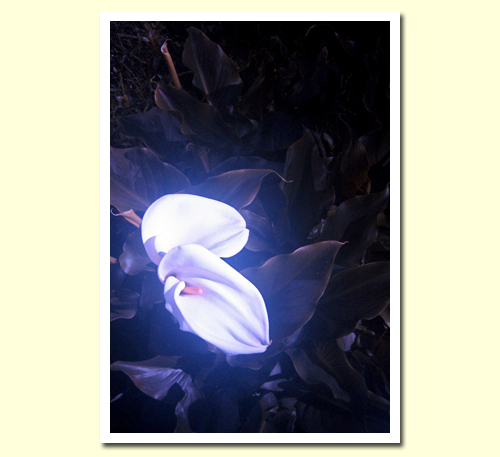Wed 6 Aug 2008
Roses Are Infrared (Violets are Ultra)
Posted by anaglyph under Gadgets, Geek, Photography
[14] Comments
GEEK ALERT!: Another camera mod that will probably have minimal interest for most of you, but I’m posting it up because I think it’s cool, and because I think you need to know.
The other day I happened to be listening to a podcast that mentioned in passing that over-exposed, processed colour negative film is mostly opaque to all visible light, but readily transmits infrared. The over-exposed bit of the neg looks ‘black’ on the neg strip. It’s actually a very deep blue to the naked eye if you hold it up to a strong light:

Translating: the ‘blue’ bit in the negative above allows infrared light to pass through. “Well, what the hell use is that, Rev!” I can hear you say. “Our eyes can’t see into the infrared!”
Aha! Your eyes can’t, Faithful Acowlyte, but maybe your digital camera can… To check, find a TV remote and press any button on it while pointing it at the camera lens. If the display allows you to see a light blinking on the end of the remote, then the camera’s chip sees infrared. This means (I can see you’re ahead of me now) that you can record infrared images!
Why would you want to do that? Because it’s pretty and mysterious! Isn’t that reason aplenty!? Just clip a piece of the end of an old neg, tape it over your camera lens and Bob’s yer uncle! The film knocks the exposure way down so for best results, set your camera ISO on its lowest setting and use a tripod and a longer exposure. If your camera is a Canon point-and-shoot, you may be able to hack the firmware to get exposure times of up to sixty seconds.
Now, for some striking results, go photograph some vegetation. Here’s a lily in my backyard. The leaves are actually a deep rich green, but because plants reflect so much infrared light (they can’t use it for photosynthesis) their foliage appears red, and sometimes even almost white.

Now. How to record ultraviolet…?
Cow Cool Rating: ☆☆☆☆☆




I hear this is technique quite popular on Anterea.
Lets see some nudes!
I second the nude motion.
What?
Atlas: I heard that aliens were invisible to infrared.
Cissy & Malach: Oh very well. Not mine I have to confess – my access to naked women is down to one and I don’t think she’d want to appear thus on my blog. And I’m pretty damn sure none of you want to see me naked, even in infrared.
Human skin looks beautiful in infrared – the human body radiates heat of course, so the flesh tones go toward a milky white.
MI: Keep up girl!
Beautiful lily.
Sorry for being prosaic after the very clever Cow-system, but professional infrared black and white film will also record into the ultraviolet as well.
But you need an old-fashioned SLR. I’m sure Violet Towne can get you one to try.
Looking forward to the next lily!
Oh, yes, I know I can shoot ultraviolet on film – it’s just about the filter. There are several that block out everything above about 400 nanometers or so. But I’m not sure if the chips on digital cameras are sensitive to UV.
400 nanometers! I retire grovelling in the face of this arcane knowledge.
Not very arcane… the wavelengths of ultraviolet start around 400nm and go through into the very tiny numbers (eventually to x-rays of course) – I know this only because the the high-falutin’ astronomical telescopes operate in those realms.
Well, digital photography hasn’t killed it – you can still take decent IR shots with a good SLR digital as long as it hasn’t got an IR filter built in. Same rules apply – you need to block as much visible light as you can (as with my filter trick), switch the cam to B&W (which incidentally makes no difference to the RAW files, I discovered recently – the RAW files contain all the colour information, no matter what you do with the camera settings) and put a red filter in front of the camera. The effect is exactly the same as IR film. Try it! It’s easy (although a little harder with a SLR – you’d need to get some medium-format exposed colour neg to make a big enough filter).
Sorry – killed 35mm IR film I meant. I could be getting into CDvVinyl territory here, but I reckon the film gave a result unobtainable with CCDs. Haven’t tried it with a CMOS sensor though – who knows?
Oh yeah, I see what you mean. Well, I agree – IR film is unmatchable so far, but theoretically you should be able to get the same results with digital. It’s only light after all. But maybe we’ll have to wait for 32 bit chips before we see anything near the quality of film.
When you get back i’d love to sit down and have a good natter about this stuff.
First a slideshow, then a natter about digital versus film photography? Guaranteed cure for insomnia! You got it…
I’m in!